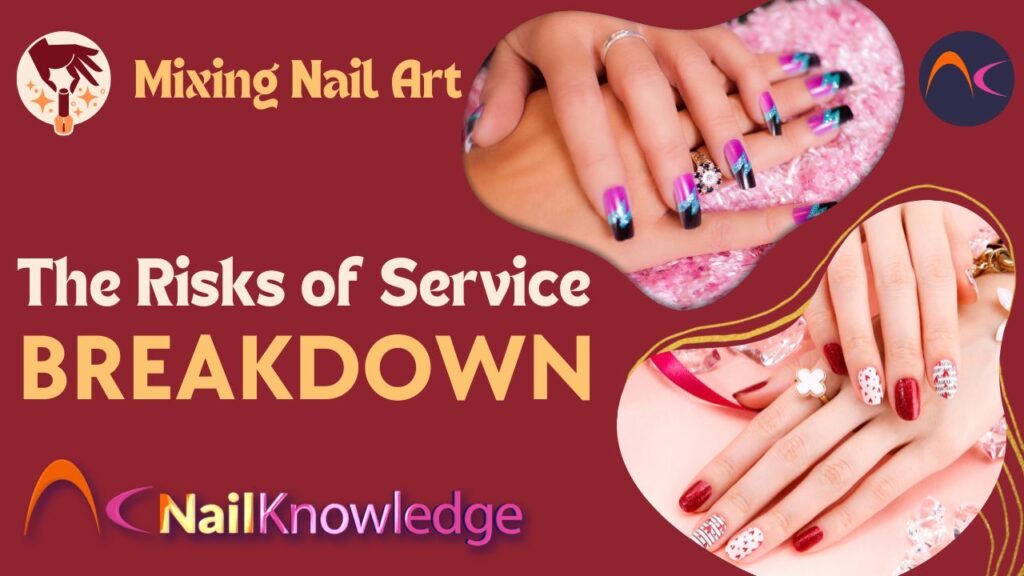Como artistas de unhas, nossa criatividade não tem limites. Estamos sempre nos esforçando para oferecer aos nossos clientes designs de nail art exclusivos e impressionantes e levando nossas habilidades para o próximo nível.
Entretanto, na busca pelo design perfeito, é essencial entender os possíveis riscos associados à mistura de produtos de nail art de diferentes marcas. Embora possa parecer tentador combinar diferentes produtos, acabamentos e texturas, fazer isso sem cautela pode levar a consequências adversas.
Neste blog, daremos uma olhada nos perigos de uma possível interrupção do serviço ao fazer nail art para ajudá-lo a garantir a segurança e a longevidade das manicures de seus clientes.
Riscos de incompatibilidade: Mistura de produtos para Nail Art de marcas diferentes
Uma marca oferece um produto que sua marca regular não tem - então, por que não misturá-las?
Um dos principais perigos de misturar produtos de nail art de marcas diferentes é a possível incompatibilidade de suas fórmulas.
Cada marca formula seus produtos de forma diferente, usando ingredientes diferentes e composições químicas ligeiramente diferentes. Misturá-los pode desencadear reações químicas entre os ingredientes, causando alterações na cor, na textura e na consistência, levando a resultados imprevisíveis para a manicure.
Compatibilidade com cabines UV/LED
Diferentes produtos em gel de diferentes marcas exigirão exposição específica às ondas UV, que variam em intensidade, tempo e duração, para garantir a cura adequada. A mistura de marcas pode, portanto, resultar em uma cura inadequada, levando não apenas à interrupção do serviço, mas também aumentando enormemente o risco de reações alérgicas.
Alteração da composição química
A adição de pigmentos, pós e folhas a produtos acrílicos ou em gel pode alterar sua capacidade de polimerização adequada, causando problemas a longo prazo, pois isso comprometerá a cura adequada. É melhor não brincar de químico e se limitar a ser um profissional de unhas. Você pode pré-misturar glitter ou pigmento em um esmalte de gel UV transparente ou em pó acrílico, mas certifique-se de que não haja mais do que 30%, que é a recomendação usual para obter uma cura adequada do revestimento.
Use somente glitters e pigmentos de grau cosmético, e NÃO versões para artesanato. Eles podem reagir com o produto ou com os solventes e causar irritação ou reação alérgica.
Possíveis reações adversas durante a remoção
Lembra-se dos ingredientes incompatíveis de que falamos antes? Eles duraram bem depois de serem aplicados na unha, mas durante o processo de remoção com a adição de acetona, a história pode ser diferente!
Uma vez diluído em um solvente potente, não temos controle sobre a reação química que pode ocorrer. Use apenas glitters, pigmentos, folhas etc. de grau cosmético que foram feitos para serem usados juntos. A remoção segura e adequada do produto é tão importante quanto a aplicação. Erros ou danos causados aqui influenciarão a durabilidade do próximo conjunto novo. Talvez você não perceba isso agora, mas em uma ou duas semanas podem haver problemas reais.
Conclusão
Por mais tentador que seja comprar novos produtos de marcas diferentes para testar designs, os perigos de misturar produtos de nail art de marcas diferentes não podem ser ignorados. Os riscos de incompatibilidade, reações químicas, tempos de cura inconsistentes, quebra de serviço e desafios na remoção podem levar a resultados ruins, clientes desapontadas ou até mesmo a um risco em potencial.
Para garantir a segurança e a longevidade de seus serviços, é melhor deixar todas as suposições de lado e seguir as orientações do fabricante, sem tentar brincar de químico. Use uma marca de boa reputação para suas criações de nail art, adicione apenas produtos de nail art de grau cosmético nas quantidades recomendadas e cure de acordo com as recomendações do fabricante.
Ao priorizar a qualidade e a segurança, você pode oferecer uma arte de unhas excepcional que faz com que seus clientes voltem sempre.


